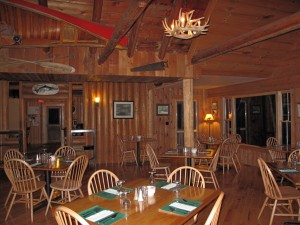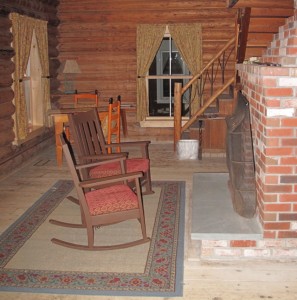 Steve Philbrick, second-generation owner of Bald Mountain Camps Resort, in Maine’s famed Rangeley Lakes region bit the bullet. After much soul seraching, he made the difficult decision to begin winter operations of the historical, traditional Maine sporting camp fronting on Mooselukmeguntik Lake. Although Philbrick is technically a second-generation owner, he took the operation over from his grandparents. And now, he’s aiming to secure the camps’ future for the next generation.
Steve Philbrick, second-generation owner of Bald Mountain Camps Resort, in Maine’s famed Rangeley Lakes region bit the bullet. After much soul seraching, he made the difficult decision to begin winter operations of the historical, traditional Maine sporting camp fronting on Mooselukmeguntik Lake. Although Philbrick is technically a second-generation owner, he took the operation over from his grandparents. And now, he’s aiming to secure the camps’ future for the next generation.
Like most traditional Maine sporting camps, Bald Mountain was open spring through fall. It’s easy accessibility made it a family favorite, not just a place for avid hunters and anglers, although it attracts those, too. The main lodge and outlying cabins look down the length of Mooselukmeguntik Lake toward the distant Presidential Range of the White Mountains; sunsets are stunning.
Choices, choices
While families return generation after generation during the warmer months, eager to swim, boat, fish, hike, and play in the surrounding wilderness, it wasn’t enough to sustain the business.
“It was a financial choice,” Steve says. “We had to make a decision, either sell — and I can hardly even talk about that, never mind consider doing it — or take the financial plunge, invest ever saved and millions more, and winterize it to keep it going, to keep the heritage alive. It sounds mushy, but that’s the choice we made.” Spurring that decision was his oldest son, Tyler, who shares Steve’s love for the property. “He expressed an interest in it and attended college for hospitality and tourism education. He wants to be part of it, he’s a new face for a new future.”
Over the past two years, the Philbricks have been winterizing the property, first the main lodge and now the cabins. (see video; and take a look at some of the other videos, including this one on ice harvesting. Now the main lodge with dining room is open and serving dinner not only to overnight guests but also the public on Wednesday through Saturday nights. It also serves lunch on Saturdays and both lunch and dinner daily during vacation weeks.
 Unpretentious dining and lodging
Unpretentious dining and lodging
We went for dinner last week. The camps serve classic Maine sporting camp fare: hearty, good, and warming with a few special touches and choices ranging from burgers and salads to chicken and steak. It’s easy, comfy, unpretentious. What I love most is the setting, a room anchored by a big fieldstone fireplace and adorned with animal trophies, even a handsome wooden canoe suspended from the ceiling.
Sitting in the room, with the fire glowing and casting a warm light on the age-burnished wood, it’s hard to tell that the lodge was rebuilt, taken apart and reassembled in order to winterize it—a process that must have required expert jigsaw puzzle skills.
What they learned winterizing the main lodge is now being repeated in the cabins, with seven open for winter guests.  “We picked up each building, put a furnace in the basement and insulated each from the outside in,” Steve says. In the process, a small fridge and microwave also were added to each cabin, allowing guests to make simple meals when the dining room isn’t open.
“We picked up each building, put a furnace in the basement and insulated each from the outside in,” Steve says. In the process, a small fridge and microwave also were added to each cabin, allowing guests to make simple meals when the dining room isn’t open.
The goal is to make the cabins more pleasing to the modern-day traveler while maintaining the rustic appeal. “We have families who have been coming back to the same cabin for multiple generations—this was their home away from home; there are a lot of memories inside that we didn’t want to cover. We took each apart stick by stick; we took great pains and effort to do so.” When those families return in the summer, the cabin looks exactly as it did inside, but now there’s heat beyond the woodstove or fireplace that’s in each one.
Restoring for the future
Preserving and restoring was important, he says, because of the property’s history. Teddy Roosevelt stayed in one cabin, and a gable had some water damage. “We dismantled the gable end to repair it, and put it back together in the same way. When I say ‘restored,’ I mean we literally restored it.”
In the process, they’ve uncovered some interesting items. When restoring another cabin, they found a carving that had been covered up by an earlier restoration. It had the date 1828 with names inscribed. “We thought the first cabin was built much later, then we found this,” Steve says, adding that property’s none of deeds go back that far. He plans to frame that and display it in the dining room, along with other artifacts and historical photos.
While summer visitors fish and swim and boat and hike, Steve expects to attract some snowmobilers, but more snowshoers and cross-country skiers in winter. “We’re nestled at foot of bald mountains, with thousands of state-owned land behind us,” Steve says. Currently, it’s make-your-own trail, but he’s negotiating for permission for an entry-level cross-country trail, a single loop from the lodge’s backdoor that he’ll groom with a small snow machine.
“I make my guests happy for free. I can tell them where to go to look for moose antlers, where to go to see deer. There are places I can send you to where you’ll never hear snowmobiles , never see them, places where if another human’s see it in the last 15-20 days, it’s because I’ve sent them there.”
And as I finish poking around the lodge and cabins, I take a few minutes to gaze skyward and am quickly mesmerized, seduced the vast expanse of inky black sky lit only by a brilliant canopy of stars, captivated by the symphonic silence of a wintry Maine night, and wishing I had booked a cabin. I will return.













Your article nicely captures the feel of this wonderful camp. For nine summers we have loved to canoe, hike, and photograph the surrounding forests and waterways. Three generations so far!
Comments are closed.